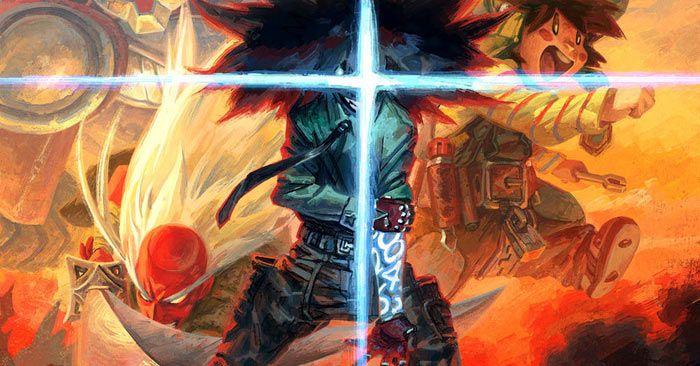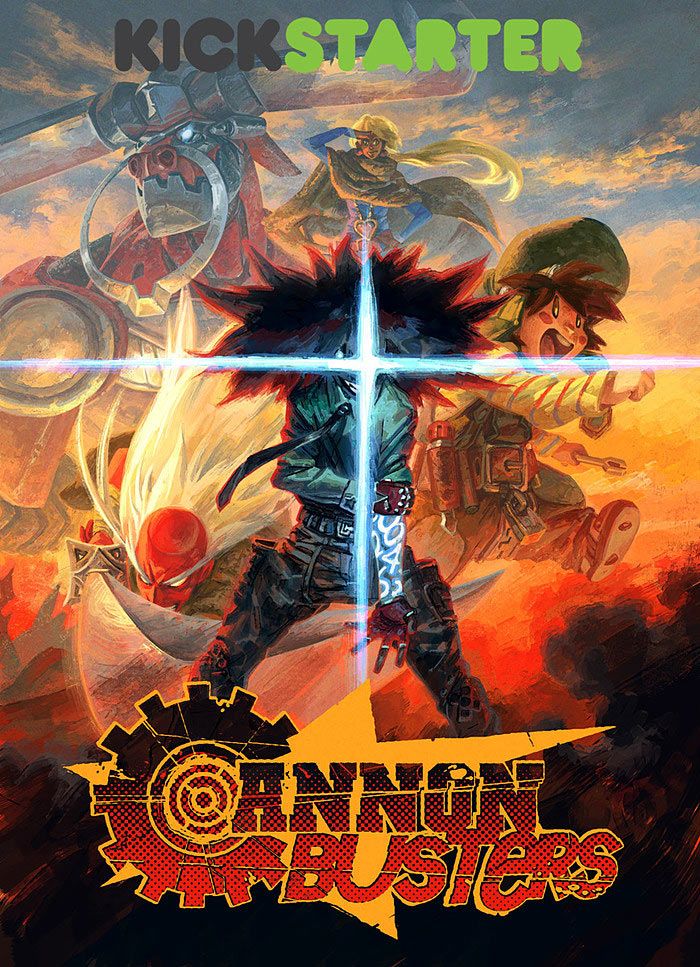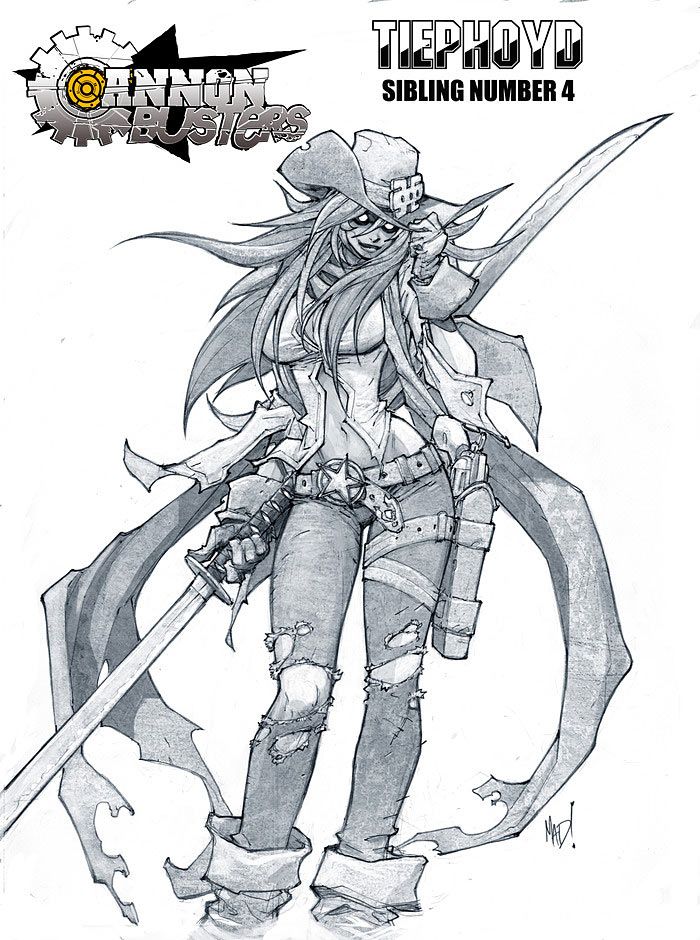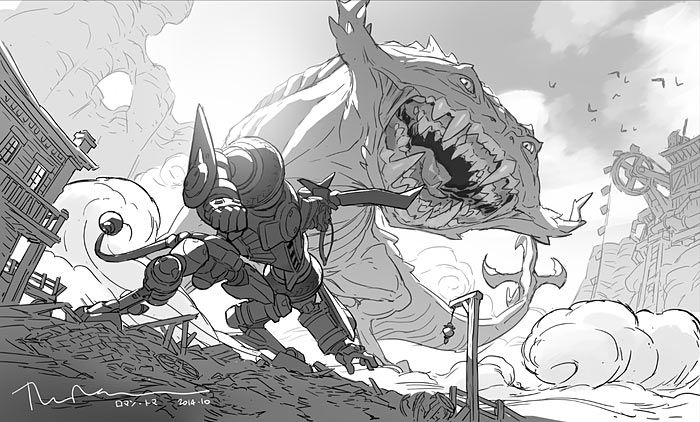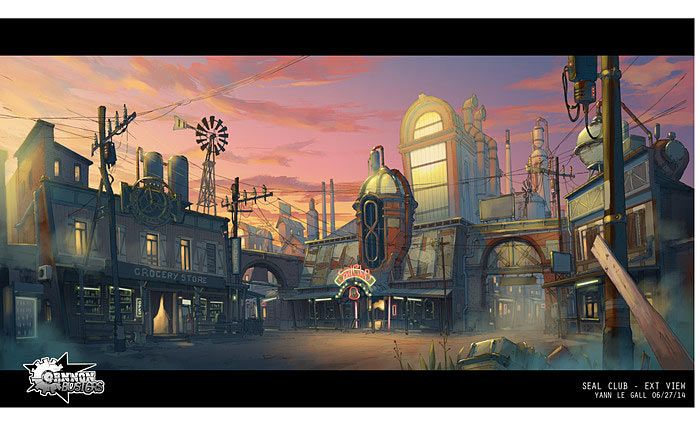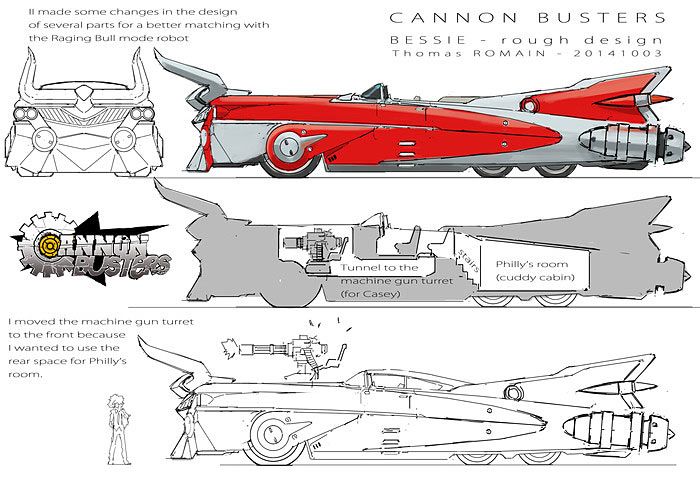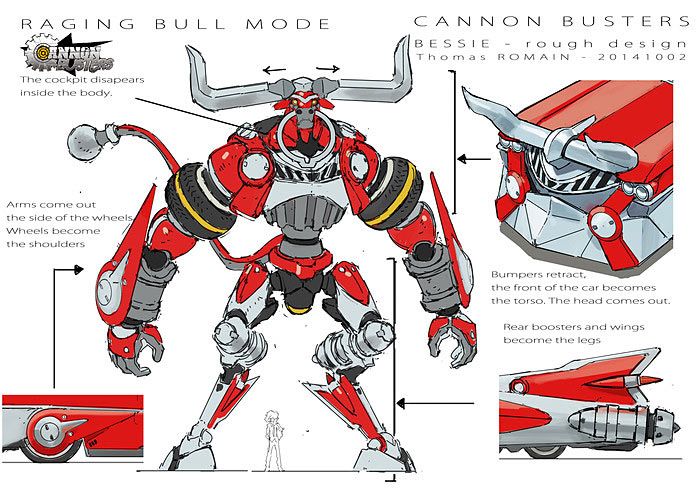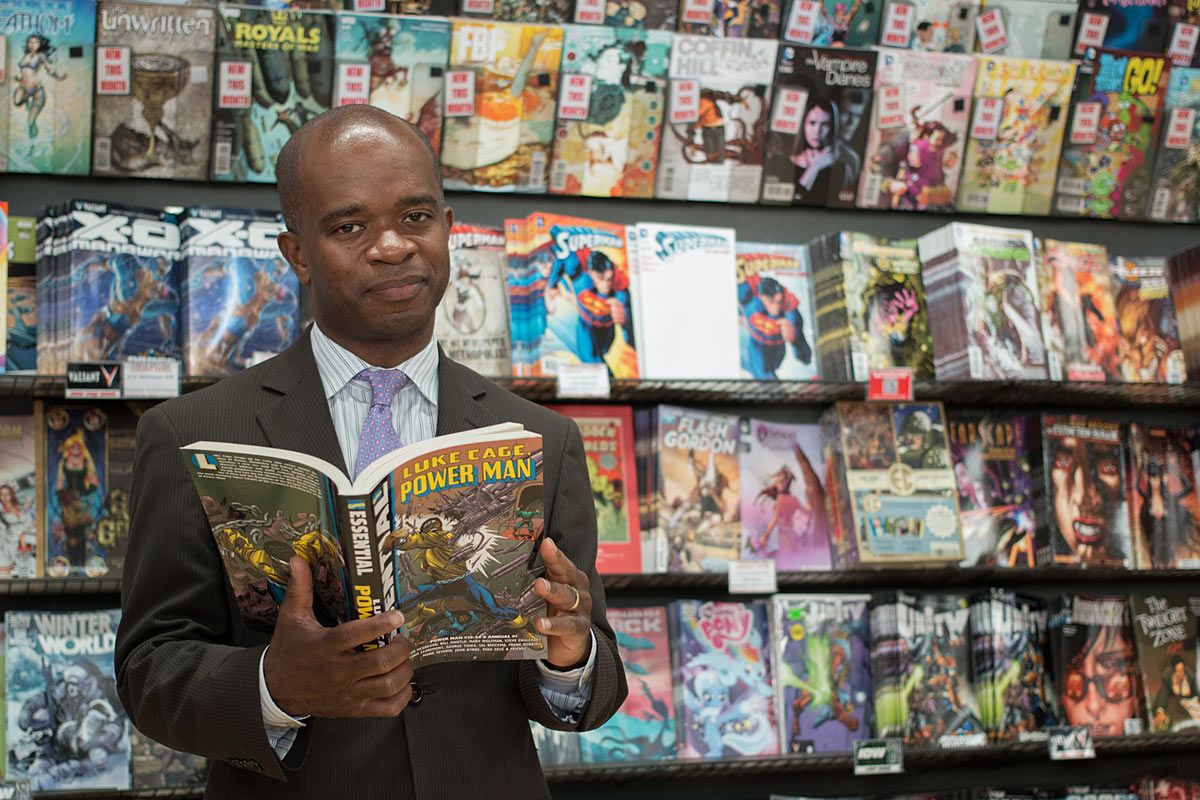THE MISSION is a weekly column spotlighting diversity in comic books, graphic novels and popular entertainment. The interviews and editorials featured will focus on successful entrepreneurs, whose accomplishments serve the goal of creating an equally diverse creative and business landscape.
LeSean Thomas is the Creative Producer/ Supervising Director of Season 1 of "Black Dynamite: The Animated Series" and Supervising Director on the show's second season.
His new Kickstarter campaign for the animated pilot "Cannon Busters" has launched with an impressive first week, in part due to the assembly of a group of well-respected animators and illustrators from around the globe.
LeSean Thomas is living The Mission.
Joseph Phillip Illidge: "Cannon Busters" started out as a comic book early in your career. Why was this the perfect idea for you to revisit at this point in your career, and why did you choose to move forward with it in animation form as opposed to comic book form? Granted, animation is your primary field of expertise, but it is a more expensive proposition than a comic book miniseries.
LeSean Thomas: In retrospect, I've always felt any time would have been the perfect time, since action/fantasy/steam punk genre comics had a market thanks to the resurgence of popular books like Joe Madureira's "Battle Chasers" among others in the 90's. The decision to try and adapt "Cannon Busters" to the moving pictures format via 2D animation was always a dream for me since, respectfully, it was animated shows and films that partially inspired me to create the property in the first place. I don't think there was an "opposition" to release it as a comic book, as I wanted both. I just think my experience/credentials weren't quite where they needed to be at the time of its inception to go straight to animation, and comics/manga were among the crafts that I was absorbing and actively participating in at the time as well, so making it a comic first was logical at the time.
Also, right when I'd managed to get the comic book off the ground, I'd already been knee-deep in developing "The Boondocks" animated series and Ilearned very quickly that creating a monthly (or bi-monthly) comic book and being a Supervising Character Designer for a hit animated TV Series, and being a Co-Director for said TV series in the same breath wasn't very effective for me, time/health-wise, so unfortunately one of them had to give. The decision to finish the comic book on my own time made the most sense, so I could build my experience/credentials in animation while working on the project at my leisure. I would get so many e-mails from people constantly about when it was coming and if I'd given up on it, so I'd release teaser pages and panels to prove I was still working on it. At the same time, animation production kept my belly full and the lights on, so that I could see the pages I was healthy enough to be working on [Laughs]. It was a tightrope strategy for sure -- not a lifestyle for those who have wives, families, and wants a social life [Laughs].

As for expenses, making quality comic books are incredibly cheaper than making quality animated content. But I think both are worth the time, money and investment.
The Mission: LeSean Thomas Ignites "Black Dynamite"
I love the diversity of characters, ethnicities and the concepts they personify. What are your favorite elements of "Cannon Busters?" What factors make it different from a number of other animated stories? Or was the goal to not be so different, but to have "Cannon Busters" be your take on the familiar?
That's very cool to hear, I created these characters over time in New York City. Growing up in an urban landscape with eight million people with up to 800 different languages being spoken (making it the most linguistically diverse city in the world), it was a natural choice for me. As for the elements, I think my favorite aspect of it is how many directions the individual characters' narratives can go in the story. The premise is very simple, but each character has a story of their own that is interesting and can last several arcs. The hope is -- should we get funded -- that we can display that in the story, if not the characters' personalities. There's a sort of dysfunctional family dynamic between the three main characters that eventually develops, since they spend so much time together. They affect each other and challenge each other to grow in very indirect ways, especially Sam's character. No one is one-dimensional -- not for very long anyway, [Laughs].

As for attempts to be different, I think it was less of a conscious effort to be different and more of a chance to grab all the familiar things I like into one idea. I think what I'm attempting to do has been done before when you dissect the different themes and story elements, but when combined, it is a rather unique mash-up and I think that's the goal: Create something that looks new, but nostalgic at the same time, so viewers can hopefully come away with something that feels fresh.
How and why did you choose Kickstarter as opposed to Indiegogo as the crowdfunding platform for "Cannon Busters," and due to the win-all or lose-all financial proposition of Kickstarter, did you find the idea of doing the campaign daunting, or did it inspire you all the more to take the chance?
I think my natural reaction to choose it was because of its popularity as a crowdfunding platform. I think Indiegogo is great as well (a shout out to Mr. James Lopez' successful 2D animated project "Hullabaloo" on Indiegogo). I personally think Kickstarter has done a very good job branding themselves, thanks to some extremely high-profile projects that achieved their goal in the last several years. More specifically, having seen four, back-to-back 2D animation-based Kickstarter campaigns in the last year achieve their goal -- Masaaki Yuasa's "Kick-Heart," Studio Trigger's "Little Witch Academia2," C.I.A.'s "Under The Dog," and just days ago, Steambot Studio's "Urbance," I was convinced that Kickstarter has created a trend in allowing unique, 2D animated projects to have a voice & potentially get funded.

The win-all or lose-all financial proposition of Kickstarter pretty much fits my personality, [Laughs]. I borrow the notion of "jumping out of a plane without a parachute and figure out how to land on the way down." I've taken more than my share of risks in the last years; some have worked out to my benefit and others haven't, but that's life in general. Nothing is guaranteed, and betting on yourself is a worthy investment. I say try to put it all out there. It's scary, sure, but I believe everything a person wants in life is usually on the other side of fear, and if you're too scared, if you can't beat fear, then I say still do it, just do it scared.
Tell me about the team you assembled for the "Cannon Busters" project, and why you chose those people, in particular, in light of all the people you know in the animation and comic book industries?
The choices kind of happened organically and mutually. I've always been a fan of Joe Madureira. He's been an idol for me in my formative years and still continues to motivate me. He is in part responsible for why I even developed "Cannon Busters" growing up during those years. He and I had built a healthy respect for each other over recent years and began communicating a lot more, as well as being active supporters of each other's works in the social network world. He was one of the first guys I really showed this project to during our time hanging out while working on "Black Dynamite: The Animated Series" Season 1 and he was super -supportive. We stayed in touch and when it was decided to go forward as a crowdfunding campaign, I asked if he would be interested in contributing designs to the project, as it'd be cool to see some MAD! designs animated in 2D form should I go forward, and he happily agreed. I owe him big for that.
Thomas Romain [Mecha Designer of "Space Dandy," Co-Director of "Oban Star Racers," Co-Creator of "Code Lyoko" & "Basquash!"] was someone I discovered six years ago. I learned of him during his run on the Sav!The World Productions series "Oban Star Racers." There was an incredibly inspiring "making of" documentary on the disc, showcasing Thomas along with the company owner and a Japanese studio, HAL Film Maker, joining forces for the first time to create an original animated series. It was a first for France and Japan to do an international co-production, I believe. Thomas was very young then, having just recently graduated from Gobelins School of the Image in France. I think I watched that documentary more than the series. It actually played as one of the catalysts in me deciding to quit my then job at Warner Bros. Animation and move to Korea to work as an independent subcontracting production/story artist the following year.
Fast forward six years and Thomas reaches out to me via Twitter, commending me for my TEDx Talk in Sinchon, Seoul Korea "Failing Your Way To Success." He said he'd seen it and was impressed and expressed that he and I were alike, as it was similar to his reasoning for moving to Japan from France and staying there to work as an animator. Needless to say I was humbled. We became pen pals via Direct Message on Twitter over the course of several months. Not long after, the opportunity to go to Tokyo came up in July. I saw that as an opportunity to visit Satelight and meet Thomas as well as the Satelight staff in person. We talked and exchanged ideas and things took off from there to where we are now.
Tim Yoon and I met during the production of "Legend Of Korra" [Book 1] back in 2010. I was living in Seoul at the time when I visited the States. I paid a visit to Nickelodeon and hung with some of the "Korra" crew and was told that Tim, the show's line producer, wanted to meet with me. He was fascinated by my exploits in South Korea and we had a long discussion about process, politics, production differences, etc. From there, we stayed in touch after "Korra," moving onto other projects. When I told him about the Kickstarter plan, he agreed to support and come on board.
Bahi JD was someone who exchanged comments about art and our works on DeviantArt years ago. He was also much younger when we first corresponded then, and blossomed into one of the most talented, up-and-coming 2D animators working today. We would also correspond online quite often during his tenure working on "Space Dandy." When I presented the idea of him possibly being involved in the "Cannon Busters" project, he agreed. He was actually in Tokyo finishing up his work on "Space Dandy" at Studio Bones and it was the first time we'd met in person.
The whole idea to launch a Kickstarter campaign began at the top of the year for me, in January. I was knee-deep into production for Season 2 of "Black Dynamite: The Animated Series" and I looked at the schedule to see when my end-date was coming up. Anyone working in seasonal TV animation knows when a project is nearing its mid-way point, the question of when the end-date is near comes up. You start seeing you're 5-8 months out from being unemployed, so you start planning your next move (take a break, line up another show project, etc.) while trying to wrap up. We were planning to launch in July at the time so that meant the show run -- and my work on it -- would be done in the fall. So I planned to launch it end of fall after the show was done.

As in life, things don't always go according to plan and in June, it was decided by Adult Swim that we were to premiere in the fall instead of the summer. I think it all worked out. At least so far...
"Cannon Busters" seems to be a smooth fusion of the Western, cyberpunk and martial arts genres. What do you consider more appealing about those genres than the superhero genre? I ask because your sensibilities seem to veer away from superheroes. Or do you consider your heroes a more distinctive and appealing take on the superhero genre, without the trappings of capes and skintight costumes?
Yeah, it's definitely a nod to those genres, as well as '80s/'90s RPG game console culture; "Final Fantasy," "Phantasy Star," "Secret of Mana," "Lunar Silver Star Story," "Chrono Trigger," etc. I don't think the superhero genre is "not as cool," per se. It's kind of like a Marvel/DC faithful not liking anime; I just think it's a personal preference. Personally, I like stories that begin and end, with new characters, worlds and POVs. You can get that in superhero stories too, but I think you have to be a fan of those characters because it's going to be about them because they are the franchise, so it'll be about them forever. I just think my tolerance for never-ending sagas surrounding the same characters for years begins to fade over time, and I like to have options. I love short stories and I get bored pretty easily, so unless I'm a hard-core fanatic of that content where I can watch it over and over and see so many different writers takes on that character's origin story and such, I tap out pretty quickly, and that's cool.
I think my sensibilities tend to reflect that in my artwork; I just really adore new ideas and new adventures. I think that's why I seem to be more lured towards indie comics. I'll still get out to see the next Batman film, because those are novel: They don't come along every week and comic companies aren't spending $200 million every five to seven years just to make one two-hour graphic novel experience like they do feature films, [Laughs].
Is "Canon Busters" a short story, or do you see it as a long-form saga? If long-form, could you see the full saga of "Cannon Busters" being told across various mediums, in addition to animation, since examples like "The Matrix" mythology seemed to benefit from the expansive possibilities of cross-platform world building?
Right now the focus is to land an 8- to 10-minute pilot (one act of a half hour) via crowdfunding. The story itself is a long-form saga with an ending. If it were to span across various mediums, it would of course be the same story for now. But anything's possible, so long as it doesn't get boring [Laughs].
Let's fast-forward into the future. Thus far, the "Cannon Busters" Kickstarter campaign is going strong, and doesn't seem to be slowing down. If the goal is met, how long do you foresee it would take to complete the "Cannon Busters" animated film short?
That depends. Producing 10 minutes is one thing, producing 15 minutes and 24 minutes is another. It's too early to speak about schedules because the campaign isn't complete and we haven't even reached our minimum yet. But should we reach our minimum, and land the talent we want beyond the campaign (post production, studios, voice talent, etc.), we expect to at least deliver by 4th quarter next year. Incentives included.
You are one of the most vocal advocates I've ever met for the need for highest-possible quality in one's work, and your assembly of notably talented creators speaks to your walking the walk as well as talking the talk. Do you consider that a non-option scenario? Bring the best possible, or don't show it?
I'm not sure. I think everyone is different. I will say that quality content is king. It's like pitching an idea. Some people choose to just show an idea or premise and couple of sketches, others prefer to have a project bible, and others who are actually in a position to produce and make things and enjoy making things can't help themselves but to have something more polished to share out of personal drive. A comic book artist/creator/writer who pitches an idea to a comic book publisher today isn't going to show a couple of character designs and a paragraph synopsis, they'll draw a few bad-assed, finished pages, some even colored and lettered. I think the latter applies to me, because from personal experience, I think it's easier for those you share your idea with to see your intended vision. I'll produce/direct an animated product if I intend to sell people on animation. I love the medium too much to do otherwise.
Joseph Phillip Illidge is the Head Writer for Verge Entertainment (www.verge.tv), a production company co-founded with Shawn Martinbrough, artist for the graphic novel series "Thief of Thieves" by "The Walking Dead" creator Robert Kirkman, and videogame developer Milo Stone. Verge has developed an extensive library of intellectual properties for transmedia development. Live-action and animated television and film, videogames, graphic novels, and web-based entertainment.
Joseph has been a public speaker on the subjects of race, comics, and politics at Digital Book World's forum, Digitize Your Career: Marketing and Editing 2.0, Skidmore College, Purdue University, on the panel "Diversity in Comics: Race, Ethnicity, Gender and Sexual Orientation in American Comic Books," and at the Soho Gallery for Digital Art in New York City.
His latest project is "The Ren," a 200-page graphic novel about the romance between a young musician from the South and a Harlem-born dancer in 1925, set against the backdrop of a crime war and spotlighting the relationship between art and the underworld. "The Ren" will be published by First Second Books, a division of Macmillan.
["The Mission" banner designed by Gavin Motnyk.]

